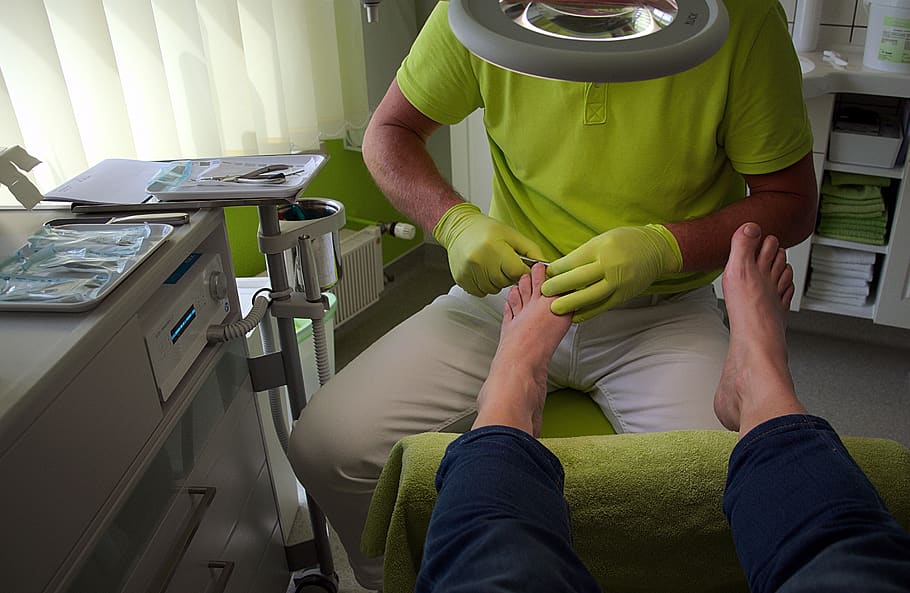When to See a Podiatrist?
Feet often cause us pain. Tight shoes, high heels, bunions, corns, calluses, warts or even foot deformities… these everyday ailments can make life difficult. In the event of discomfort or repeated pain, what should you do, and who should you contact?
Contents
– The podiatrist treats the foot and its deformities
– When to consult a podiatrist?
– Podiatrist: who is concerned?
The foot plays a vital role in maintaining balance and walking. As a result of injury, damage or hereditary causes, the foot can become deformed to a greater or lesser extent and may require surgery or orthopaedic inserts.
For foot care, you may need to consult several types of specialists such as the podiatrist, the orthopaedist, and the beautician.
The podiatrist, which we will be talking about in this post, has a paramedical function. Let’s see closer below.
The podiatrist treats the foot and its deformities.
The podiatrist treats foot and toenail disorders based on a medical prescription. They are also authorised to carry out treatments without a prescription, but your insurance will not reimburse these.
The profession of podiatrist has two facets:
– pedicure;
– podiatry care.
Note: the podiatrist may be required to intervene in many areas (e.g. sports), particularly while monitoring specific at-risk populations.
The Podiatrist is also a pedicurist.
The podiatrist is responsible for monitoring superficial problems of the foot; this is the part that is called pedicure. He must diagnose and treat all skin problems such as
– corns and calluses
– mycosis;
– warts…
Podiatrist: Podiatry

The podiatrist can also treat more severe pathologies and foot deformities:
– whether they are hereditary in origins, such as clubfoot or hollow feet;
– whether they are the result of an accident, such as hallux rigidus;
– whether they have developed due to poor posture or unsuitable footwear, such as claw toes.
To remedy these conditions, the podiatrist has several solutions:
– manufacture of foot orthoses or orthopaedic shoes;
– the fitting of a foot splint or night brace;
– the straightening of nails (or orthonyxis) and their repair through onychoplasty.
When should you see a podiatrist?
Don’t wait until you are in pain to go to a podiatrist! The appearance of discomfort when walking should automatically lead you to consult him. He will be able to prevent corns, ingrown toenails or deformities.
As a preventive measure, it is advisable to consult a podiatrist regularly (once a year), even if you do not feel any discomfort or pain. This way, the podiatrist can detect any problems early on.
Please note: for children and adolescents, it is advisable to visit twice a year. You can bring your children of any age, even babies.
Podiatrists: who is involved?
The podiatrist works with a wide range of people. However, the foot must be monitored more regularly in:
– people with diabetes, whose foot problems can lead to disabling complications;
– arterial patients, for the same reasons
– athletes;
– the elderly
– young children, etc.
Hope this post has helped you get an idea of where to go in case of foot discomfort. Please, do not hesitate to share your comments below. Your opinion is important to us!
Read more:
Why and When to See a Podiatrist;
How to Relieve Foot Pain Caused by High Arches?
Definition of Podiatry and Treatments;
All You Need to Know About Orthopaedics (or Orthopedics);
Why You Should Use Orthopaedic Insoles;
Claw Toe: Causes, Different Forms, Consequences, Avoiding Surgery;




Preventive visits to the podiatrist sound much better than waiting for a foot problem to happen. If such a thing happens to you, you might not be able to walk to places you need to go to like the office or the grocery store, thus putting your life to a screeching halt. I’ll make sure I avoid that by regularly visiting a local podiatrist so I have no worries about those things.